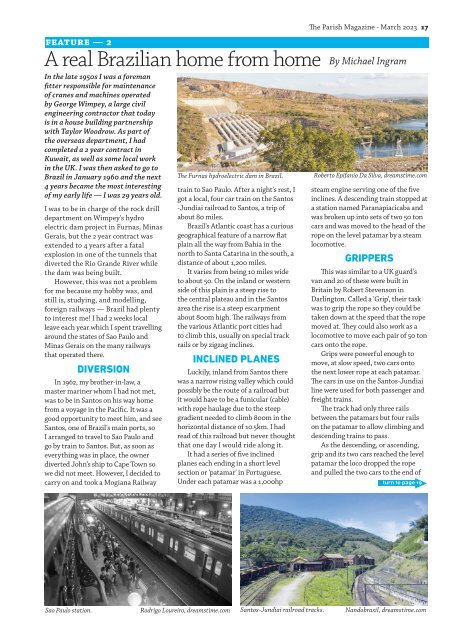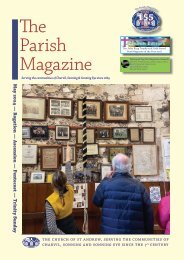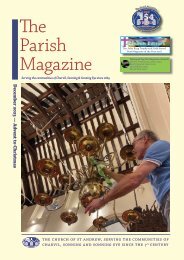The Parish Magazine March 2023
Serving the communities of Charvil, Sonning and Sonning Eye since 1869
Serving the communities of Charvil, Sonning and Sonning Eye since 1869
You also want an ePaper? Increase the reach of your titles
YUMPU automatically turns print PDFs into web optimized ePapers that Google loves.
feature — 2<br />
A real Brazilian home from home<br />
In the late 1950s I was a foreman<br />
fitter responsible for maintenance<br />
of cranes and machines operated<br />
by George Wimpey, a large civil<br />
engineering contractor that today<br />
is in a house building partnership<br />
with Taylor Woodrow. As part of<br />
the overseas department, I had<br />
completed a 2 year contract in<br />
Kuwait, as well as some local work<br />
in the UK. I was then asked to go to<br />
Brazil in January 1960 and the next<br />
4 years became the most interesting<br />
of my early life — I was 29 years old.<br />
I was to be in charge of the rock drill<br />
department on Wimpey's hydro<br />
electric dam project in Furnas, Minas<br />
Gerais, but the 2 year contract was<br />
extended to 4 years after a fatal<br />
explosion in one of the tunnels that<br />
diverted the Rio Grande River while<br />
the dam was being built.<br />
However, this was not a problem<br />
for me because my hobby was, and<br />
still is, studying, and modelling,<br />
foreign railways — Brazil had plenty<br />
to interest me! I had 2 weeks local<br />
leave each year which I spent travelling<br />
around the states of Sao Paulo and<br />
Minas Gerais on the many railways<br />
that operated there.<br />
DIVERSION<br />
In 1962, my brother-in-law, a<br />
master mariner whom I had not met,<br />
was to be in Santos on his way home<br />
from a voyage in the Pacific. It was a<br />
good opportunity to meet him, and see<br />
Santos, one of Brazil's main ports, so<br />
I arranged to travel to Sao Paulo and<br />
go by train to Santos. But, as soon as<br />
everything was in place, the owner<br />
diverted John's ship to Cape Town so<br />
we did not meet. However, I decided to<br />
carry on and took a Mogiana Railway<br />
<strong>The</strong> Furnas hydroelectric dam in Brazil.<br />
train to Sao Paulo. After a night's rest, I<br />
got a local, four car train on the Santos<br />
-Jundiai railroad to Santos, a trip of<br />
about 80 miles.<br />
Brazil's Atlantic coast has a curious<br />
geographical feature of a narrow flat<br />
plain all the way from Bahia in the<br />
north to Santa Catarina in the south, a<br />
distance of about 1,200 miles.<br />
It varies from being 10 miles wide<br />
to about 50. On the inland or western<br />
side of this plain is a steep rise to<br />
the central plateau and in the Santos<br />
area the rise is a steep escarpment<br />
about 800m high. <strong>The</strong> railways from<br />
the various Atlantic port cities had<br />
to climb this, usually on special track<br />
rails or by zigzag inclines.<br />
INCLINED PLANES<br />
Luckily, inland from Santos there<br />
was a narrow rising valley which could<br />
possibly be the route of a railroad but<br />
it would have to be a funicular (cable)<br />
with rope haulage due to the steep<br />
gradient needed to climb 800m in the<br />
horizontal distance of 10.5km. I had<br />
read of this railroad but never thought<br />
that one day I would ride along it.<br />
It had a series of five inclined<br />
planes each ending in a short level<br />
section or 'patamar' in Portuguese.<br />
Under each patamar was a 1,000hp<br />
<strong>The</strong> <strong>Parish</strong> <strong>Magazine</strong> - <strong>March</strong> <strong>2023</strong> 17<br />
By Michael Ingram<br />
Roberto Epifanio Da Silva, dreamstime.com<br />
steam engine serving one of the five<br />
inclines. A descending train stopped at<br />
a station named Paranapiacicaba and<br />
was broken up into sets of two 50 ton<br />
cars and was moved to the head of the<br />
rope on the level patamar by a steam<br />
locomotive.<br />
GRIPPERS<br />
This was similar to a UK guard's<br />
van and 20 of these were built in<br />
Britain by Robert Stevenson in<br />
Darlington. Called a 'Grip', their task<br />
was to grip the rope so they could be<br />
taken down at the speed that the rope<br />
moved at. <strong>The</strong>y could also work as a<br />
locomotive to move each pair of 50 ton<br />
cars onto the rope.<br />
Grips were powerful enough to<br />
move, at slow speed, two cars onto<br />
the next lower rope at each patamar.<br />
<strong>The</strong> cars in use on the Santos-Jundiai<br />
line were used for both passenger and<br />
freight trains.<br />
<strong>The</strong> track had only three rails<br />
between the patamars but four rails<br />
on the patamar to allow climbing and<br />
descending trains to pass.<br />
As the descending, or ascending,<br />
grip and its two cars reached the level<br />
patamar the loco dropped the rope<br />
and pulled the two cars to the end of<br />
turn to page 19<br />
Sao Paulo station. Rodrigo Loureiro, dreamstime.com Santos-Jundiai railroad tracks. Nandobrasil, dreamstime.com

















